By Dan McFadden
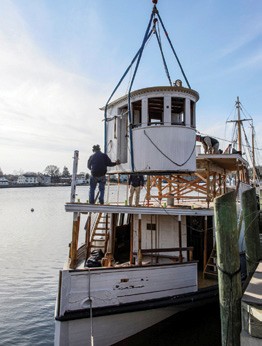 For anyone who has stopped by the shipyard at Mystic Seaport in Mystic, Connecticut over the last six months, it has been a beehive of activity with multiple vessels being worked on at the same time. Officially named the Henry B. duPont Preservation Shipyard, the facility was created to enable the museum to maintain and restore its collection of historic watercraft, a task that would be prohibitively expensive to carry out at commercial yard rates. However, the shipyard also has the mission to preserve and teach traditional skills and techniques, and to be a leader in the development and practice of maritime preservation. The shipyard has been doing all of these things in the last year as it comes off an intense period of work on a variety of interesting projects.
For anyone who has stopped by the shipyard at Mystic Seaport in Mystic, Connecticut over the last six months, it has been a beehive of activity with multiple vessels being worked on at the same time. Officially named the Henry B. duPont Preservation Shipyard, the facility was created to enable the museum to maintain and restore its collection of historic watercraft, a task that would be prohibitively expensive to carry out at commercial yard rates. However, the shipyard also has the mission to preserve and teach traditional skills and techniques, and to be a leader in the development and practice of maritime preservation. The shipyard has been doing all of these things in the last year as it comes off an intense period of work on a variety of interesting projects.
Sabino’s pilothouse being removed. The house and canopy top had to be removed to access the engine and boiler and to permit the steamboat to clear the entrance doors to the main shop where the restoration would take place. © Mystic Seaport
“This has been an unusual period in terms of the number of projects under way at the same time, and to be entrusted to work on vessels for two other organizations,” said Dana Hewson, Vice President of Watercraft Preservation and Programs at Mystic Seaport. “We appreciate being recognized as a center of excellence in the maritime preservation community.”
Sabino
The primary focus of the shipyard for the last year and a half has been the restoration of the museum’s steamboat Sabino. Built in 1908 in East Boothbay, Maine, the Sabino is an example of a small passenger ferry common in coastal areas in the years before the automobile. The 57-foot steamboat came to the Mystic Seaport in the early 1970s and has been designated a National Historic Landmark. Her role at the museum is as a working exhibit, and she has been operated seasonally offering visitors 30-minute cruises above the Mystic River bascule bridge during the day and a 90-minute cruise downriver each evening.
By 2014, Sabino had reached a point where regular maintenance had been superseded by the need for some involved restoration work. This is a natural occurrence for any historic vessel. The primary issues were to replace the keelboats, replace some frames and planking, and attend to some deterioration around the shaft log and deadwood in the stern. (The shaft log is the wood timber through which the propeller shaft exits the hull.) The difficult decision was made to take her out of service for at least one year so this work and other necessary tasks could be completed in the shipyard. While this would take her out of operation, the extended period in the yard would permit a comprehensive restoration to preserve her for the next 25-30 years.
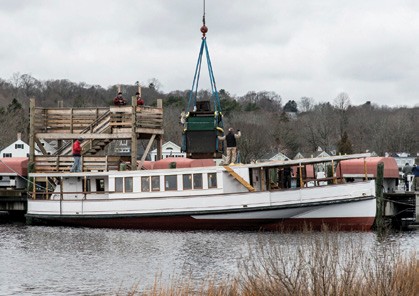 Over the last year, the shipwrights replaced the stairs, forward deck, the horn timber, the shaft log, some of the deadwood, and a number of frames, as well as the keel bolts and about 20-25 planks of varying lengths. She also underwent some repairs to her bulwarks and upper deck.
Over the last year, the shipwrights replaced the stairs, forward deck, the horn timber, the shaft log, some of the deadwood, and a number of frames, as well as the keel bolts and about 20-25 planks of varying lengths. She also underwent some repairs to her bulwarks and upper deck.
Steamboat Sabino’s boiler being lifted out of the hull early in the restoration. The stack, canopy and pilothouse have already been removed. © Mystic Seaport
The mandate is always to preserve as much as possible of the original fabric of the vessel, and when that is not possible to replace with the same materials. However, at times it is prudent to make a change. Instead of white oak, live oak left over from the Charles W. Morgan restoration was used.
“We’ve sort of made a policy that when we can we shift over to live oak for framing just for the durability,” said Walter Ansel, the lead shipwright on the project. “It’s similar to our practice of switching over to bronze screws instead of iron – you get more time out of the option.”
For similar reasons, the upper deck received a plywood top layer sheathed in fiberglass. While obviously not original to her 1908 construction, the durability and stiffness of the modern materials will greatly protect the top of the vessel from freshwater intrusion and wear and tear from the feet of the thousands of passengers who tread the deck each year. Once painted, the new deck surface will not appear notably different from the one it replaced.
As the restoration of the hull began, Sabino’s mechanical systems were lifted out of the boat and moved into the machine shop. The original 1908 engine, a 75 hp, twocylinder, compound steam engine built downriver in nearby Noank, will continue to power the boat. Unfortunately, a full inspection of the 1941-vintage boiler indicated it needed to be replaced. Marine boilers of this small size are a rarity, and a new one would have to be custom designed and built. This added potentially $125,000 to the project and also affected the timeline, as a designer and manufacturer had to be identified and contracted to do the work.
The decision was made early this year to finish the hull restoration and launch Sabino in July without a new boiler to provide time to raise the funds and get one fabricated. In the meantime, Sabino will function as a dockside exhibit. The goal is to have her fully operational for summer 2017.
“We are disappointed in the decision we needed to make, but we believe it is in the best interest of the vessel,” Steve White, President of Mystic Seaport, said at the time. “We maintain our commitment to returning Sabino to steam operation.”
Mayflower II
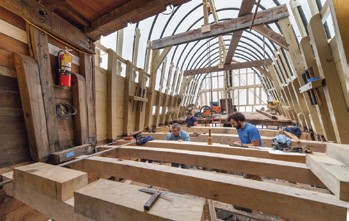 For the second winter in a row, the shipyard has been home to Mayflower II, the replica of the ship that brought the Pilgrims to the New World in 1620. The vessel is owned by Plimoth Plantation, which has plans to sail the vessel as part of the celebration of the 400th anniversary of the Pilgrims’ arrival. To be able to do so, Mayflower II needed a comprehensive restoration, and the organization needed someone who understood historic preservation.
For the second winter in a row, the shipyard has been home to Mayflower II, the replica of the ship that brought the Pilgrims to the New World in 1620. The vessel is owned by Plimoth Plantation, which has plans to sail the vessel as part of the celebration of the 400th anniversary of the Pilgrims’ arrival. To be able to do so, Mayflower II needed a comprehensive restoration, and the organization needed someone who understood historic preservation.
Shipwrights work on Mayflower II’s new deck beams. © Mystic Seaport
“We required partners for the Mayflower II restoration who will remain faithful to the integrity of the ship’s builders’ work and intent in 1955,” said Kate Sheehan, spokesperson for Plimoth Plantation. “Mystic Seaport’s team has demonstrated time and again their dedication to maintaining the utmost standards of preservation. It was also important to have a degree of flexibility on the work schedule, as our goal has been to keep the ship on exhibit as much as possible.”
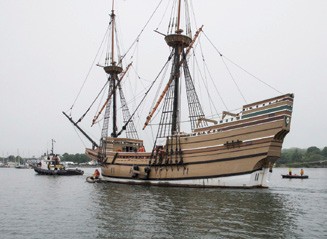 The result has been a productive collaboration for both museums. Mayflower II spends the summers and fall on exhibit at her berth in Plymouth harbor, and then is towed to Mystic Seaport after Thanksgiving to be worked on over the winter and spring. The first year was dedicated to a thorough survey and the development of a restoration plan along with some repairs and cosmetic work. The just-completed second phase began to address some of the structural issues.
The result has been a productive collaboration for both museums. Mayflower II spends the summers and fall on exhibit at her berth in Plymouth harbor, and then is towed to Mystic Seaport after Thanksgiving to be worked on over the winter and spring. The first year was dedicated to a thorough survey and the development of a restoration plan along with some repairs and cosmetic work. The just-completed second phase began to address some of the structural issues.
Mayflower II departing Mystic for Plymouth under tow by the tug Jaguar on June 5 © Mystic Seaport
“Over the last six months, Mystic Seaport’s shipwrights and Plimoth Plantation’s maritime artisans have continued necessary stabilization efforts,” said Sheehan. “This past winter, the team focused on replacing much of Mayflower II’s half-deck area, installing new topmast rigging, and attending to improvements in the tween deck that may not be as obvious to visitors.”
Mayflower II is scheduled to return to Mystic in November. The plan is for the ship to spend an extended period of nearly two years in the shipyard to move the project long to meet the 2020 anniversary deadline.
Amistad
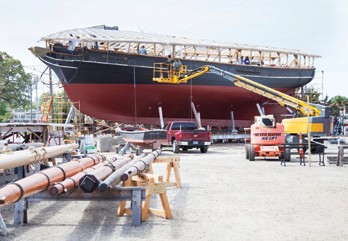 Returning to the shipyard for the past winter was the Freedom Schooner Amistad, Connecticut’s official state vessel. Now under the stewardship of Discovering Amistad, a nonprofit organization newly created to manage and operate the vessel, the ship was hauled out for her crew to begin to address a number of maintenance issues that were a result of her neglect over the past few years.
Returning to the shipyard for the past winter was the Freedom Schooner Amistad, Connecticut’s official state vessel. Now under the stewardship of Discovering Amistad, a nonprofit organization newly created to manage and operate the vessel, the ship was hauled out for her crew to begin to address a number of maintenance issues that were a result of her neglect over the past few years.
Freedom Schooner Amistad hauled out of the water in the shipyard © Mystic Seaport
Amistad was hauled out so the shipyard and her crew could repair some planks, caulk the seams, and repaint her topsides and bottom, as well as work on her systems and other tasks. Her engines were removed, and remanufactured ones ordered. The bulk of this work was done by a combination of Mystic Seaport staff and volunteers and Amistad staff and volunteers.
The schooner was launched on June 7, 2016 and had her masts stepped the following week. Fitting out, including reinstallation of the engines, continues with the goal to return her to operation this summer.
Emma C. Berry
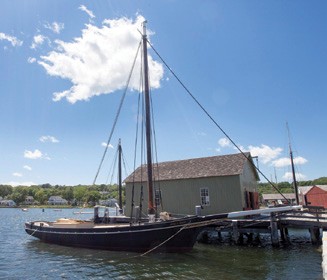 A milestone of sorts will be reached this year as the Noank smack Emma C. Berry turns 150 years old. The Berry is a type of fishing vessel know as a “well smack,” notable for the wet well in its hold that permitted sea water to circulate and keep the catch alive while it was transported to market in the age before refrigeration. Boats like the Berry were once common a sight up and down the East Coast. In fact, Noank smacks were sought after and had a reputation for being swift sailors and good sea boats.
A milestone of sorts will be reached this year as the Noank smack Emma C. Berry turns 150 years old. The Berry is a type of fishing vessel know as a “well smack,” notable for the wet well in its hold that permitted sea water to circulate and keep the catch alive while it was transported to market in the age before refrigeration. Boats like the Berry were once common a sight up and down the East Coast. In fact, Noank smacks were sought after and had a reputation for being swift sailors and good sea boats.
Emma C. Berry with her new (old) mast © Mystic Seaport
The Berry is presently rigged as a sloop, which was her original configuration. Later in her career, she was re-rigged as a schooner for the ease of sail handling and carried that rig when she was sold down to Maine and later New Jersey. When she was donated to Mystic Seaport in 1969, the museum decided to return her to a sloop rig to represent her as she would have been seen at her launch in 1866. (For more information about the boat’s history, please see the newly published book Celebrating the Emma C. Berry, by the late Lawrence R. Jacobsen.)
The Berry is in very good condition and has only required regular maintenance in recent years. That said, she was hauled out late last fall to receive a fresh coat of paint and some primping for the anniversary. One issue that was addressed this spring was her mast. Rot had compromised the spar, which dates to the early 2000s. The first option was to fabricate a new mast from another one in the yard. This had the advantage of recycling existing material, but once the turning process began pockets of rot were discovered beneath the surface and the project had to be abandoned. Instead, a new base was “scarfed” onto the existing mast and placed back on the vessel.
In recognition of the 150th anniversary, the Berry was the featured vessel of the museum’s Antique & Classic Boat Rendezvous last month, and she led the annual boat parade down the Mystic River on that Sunday. Plans are to have her joined by other Noank-built boats.
This spring has seen the shipyard at its best: a busy hub of activity on a variety of vessels. Mayflower II is now back hosting tourists in Plymouth, Amistad is afloat, and Sabino is being readied to go back in the water. But the work continues. Next up is a new rig for the 1921 Grand Banks fishing schooner L.A. Dunton. The goal is to have her lower masts stepped by Columbus Day and the full rig complete by next spring. Shipwrights will work over the summer milling wood and parts to be installed when Mayflower II returns for her next round of work, and of course every vessel, small or large, needs its regular maintenance. The work never ends.
Those interested in supporting the fabrication of a new boiler for Sabino are encouraged to contact Mystic Seaport at (860) 572-5365 or online at mysticseaport.org/supportsabino.
Dan McFadden is Mystic Seaport’s Director of Communications. An enthusiastic member of The Catboat Association, Dan is currently restoring a 1903 Daniel Crosby catboat. He recently launched his 1967 MacKenzie Cuttyhunk Bass Boat, on which he and his wife enjoy the waters of southern New England.




